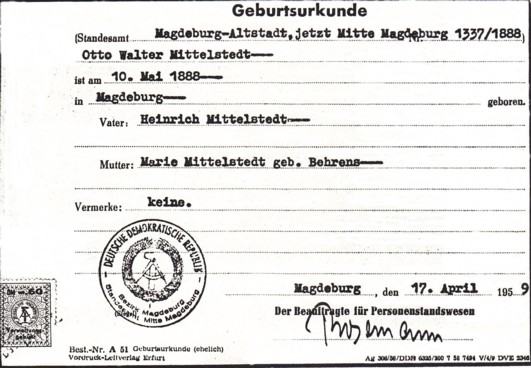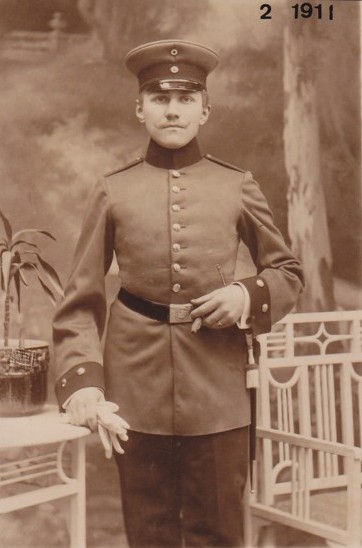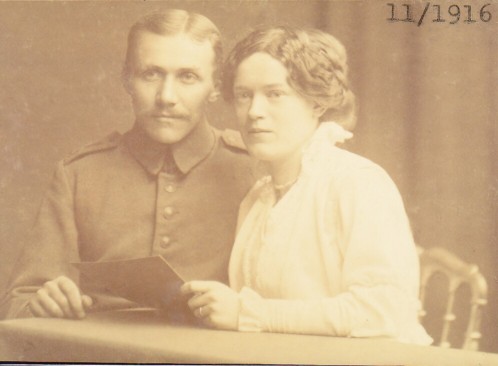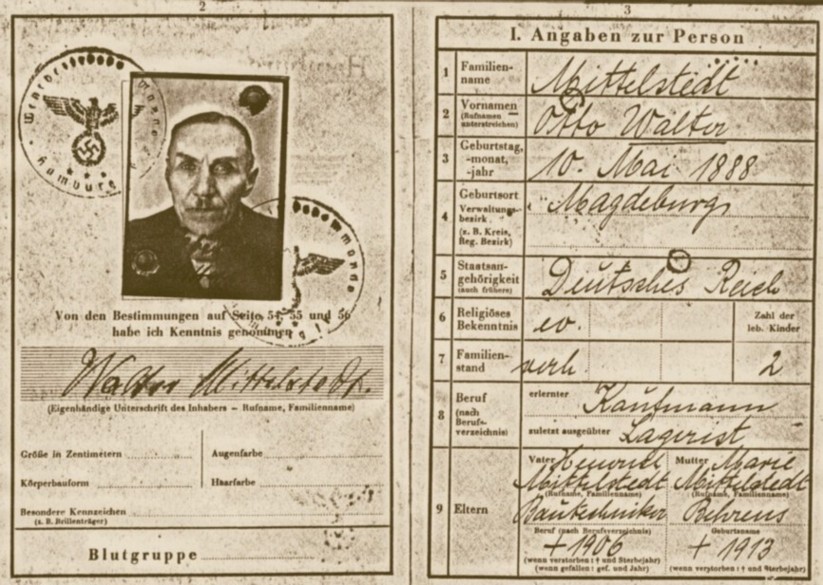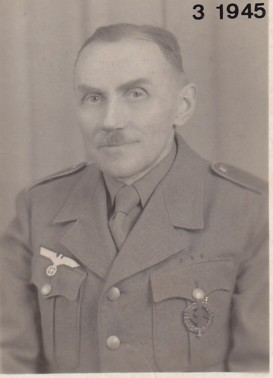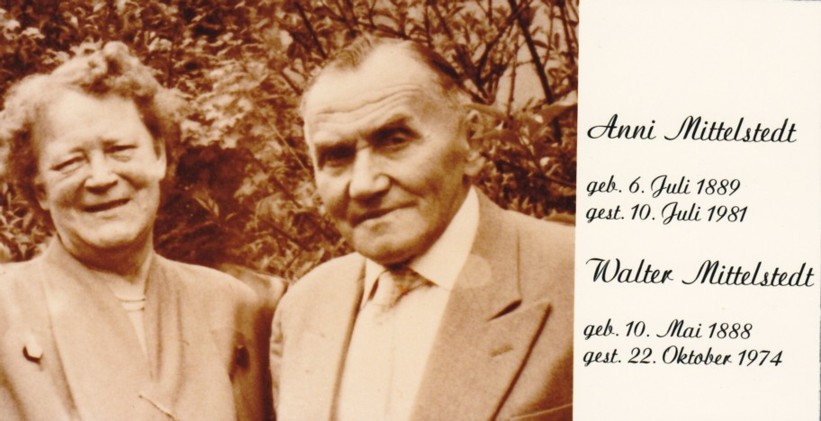My grandfather Otto Walter, known to everyone as
Walter, was born in Magdeburg. His father had debt problems and
therefore distributed his children among relatives to be brought up by
them. From the age of 12 Walter lived with an aunt
Anna (a sister of his mother) in Apendorf near Salzwedel and learned
the trade of tailor.
The reverse side of the following photo says: "Metz, in February 1911,
bei den Pionieren [with the Pioneers]". Der Volks-Brockhaus
dictionary (1955) defines the Pionieren: "Members of the engineering
troops of the army: Build temporary bridges and crossovers with ferries
and pontoons, remove obstacles with explosives, construct barriers."
Otto Walter at age 22 with the "Pionieren"
Otto Walter and Anni in1916
Otto Walter married his landlord's daughter, Anni Elise
Marie
Mahler, in October 1916. Their marriage certificate locates both their
addresses at Margarethenstrasse 39 in Hamburg. This apparently was an
apartment building where Paul Mittelstedt, a brother of Otto Walter,
also
lived.
Otto Walter served with the light field
artillery in
World War I in Poland and Russia in 1917 and on the Western Front
in 1918. My father once said, "He apparently got through the war
without injuries; I never saw any wounds or was told about any."
I was told Otto Walter liked motor-bike riding and in the 1920s
travelled extensively. This is confirmed by his driver's license issued
in Hamburg, dated 7 October 1924, which says he successfully
passed his driving test on May 9 with a "Kraftrad" i.e. motorbike.
Otto Walter had two children, Walter Johann Robert (1921-2008) and Käte [or Kaete]
(1926-
). He became
an
independent businessman who bulk-purchased tobacco products. His
daughter (i.e. my aunt) whom I interviewed by phone when she was 85
said the firm was started in Magdeburg and transferred to Hamburg.
The
business is listed in the Hamburg telephone book
for 1934
[Amtliches Fernsprechbuch
fuer den Reichspostdirektionsbezirk Hamburg 1934] which reads:
"Tabakwaren engros [Tobacco Products
wholesale], Hmb11, Anberg 3" . "Anberg" is a street in central Hamburg, next to the
famous landmark the Michaelis Kirche [Michaelis Church/Cathedral],
about 300 metres from the Elbe River, in the district
Neustadt.
In 1937 Otto Walter joined the Nazi Party and renewed his membership in
1940. The following are three pages from his membership booklet. Pages
3-5 (not here reproduced) have the "Vorwort" [Forward] by Adolf Hitler;
pages 6-7 headed "Ehrentafel" [List of Honour] lists the Nazis who died
in Hitler's attempted coup in November 1923; page 10 titled "Zur
Beachtung" [For Observance] itemises some of the responsbilities of
Party membership; page 11 is for recording the date of the member's
oath of allegiance to the Fuehrer but is not filled out.
Otto Walter's tobacco business was destroyed by bombs in
1943. From
July 24 to August 3, 1943, Hamburg suffered six major bombing raids
which became known as the "Battle of Hamburg". 45,000 people died and
900,000 lost their homes. (Middlebrook, M. 1984 The Battle of
Hamburg, Penguin Books, pp 328, 330) Otto Walter lived
in the same building where his tobacco business was located. His
daughter, Käte, remembered that
the alarms awoke her father who immediately led his family downstairs,
then down the street to the shelters underneath the Michaelis Church
which were soon crowded with people. Kaete said this was in July.
The date was probably July 27-28 when the main bombing raid
occurred.The word "Feuerstorm"
(Firestorm) was coined to describe the "sea of fire", centred 5km east
of the Michaelis Church, that obliterated
whole suburbs and killed about 35,000 people in one night, most of them
burned to death.
Otto Walter's son (i.e. my father) said the business continued as a
shop which was lost after the War due to the membership in the Nazi
Party — but this I've
failed to confirm. My father also said: "He had no interest in
politics; he was only a
member of the Party for the advantages it brought."
Wehr Pass [Service Record Booklet] March 21, 1944, pp 4-5
The next photo shows Otto Walter in 1945. The close-combat badge
suggests he was with the
infantry. He didn't experience military action, however, because German
forces in Hamburg surrendered without a battle when British forces
neared the city on May 3.
Otto Walter was retired when at age five I emigrated to Australia with
my
parents. I recall many visits to "Opa" and "Oma" [Grandfather and
Grandmother]. He was a great storyteller and narrated the usual
children's stories besides a little history and current events. One
day he summarized a newspaper report about a banana
shipment from Africa which included a poisonous snake which bit a
worker in Germany. I was eating a banana at the time and was startled
but he reassured me that it happened only once and bananas are safe.
In the 1960s Otto Walter and his wife occasionally stayed with their
daughter Käte on Wattenberg in Austria. Wattenberg is a high mountain
near the town of
Wattens
in Austria in a picturesque area
of forests and mountains.
Walter spent the last four years of his life in a Hamburg nursing home
where I visited him a few months before his death in 1974 when he was
86.
The following photo is from about 1960:
Otto Walter Mittelstedt had two children:
Walter Johann Robert
(1921-2008)
Käte Steinlechner (1926- )
